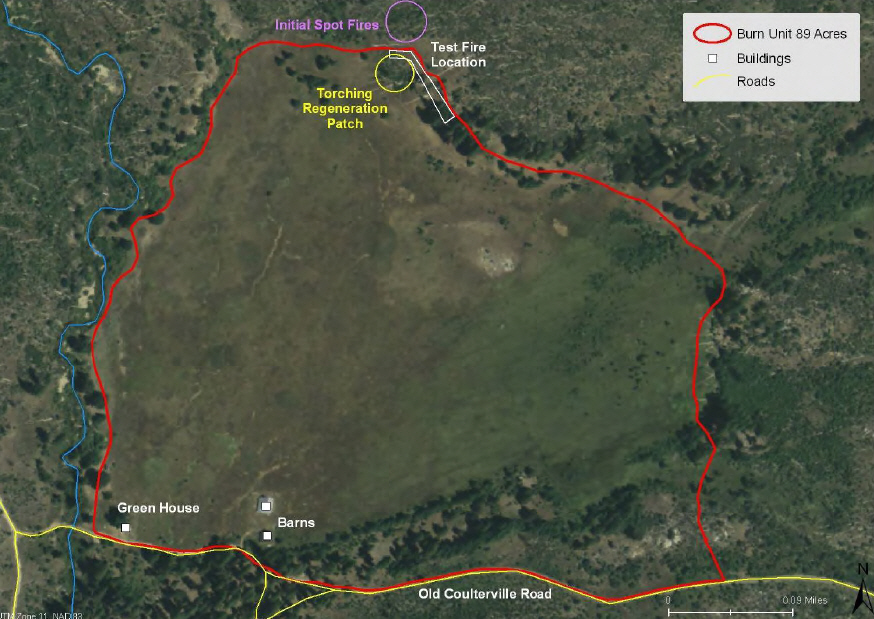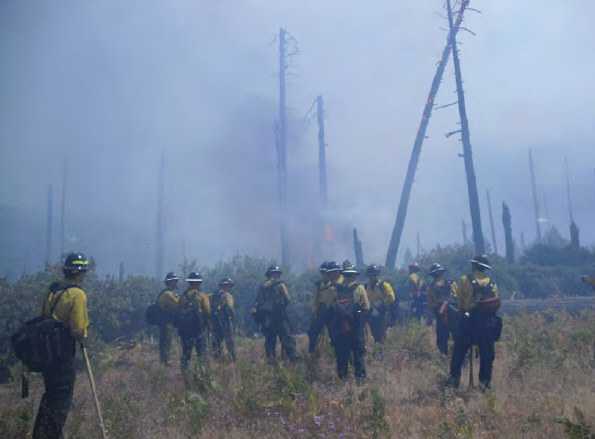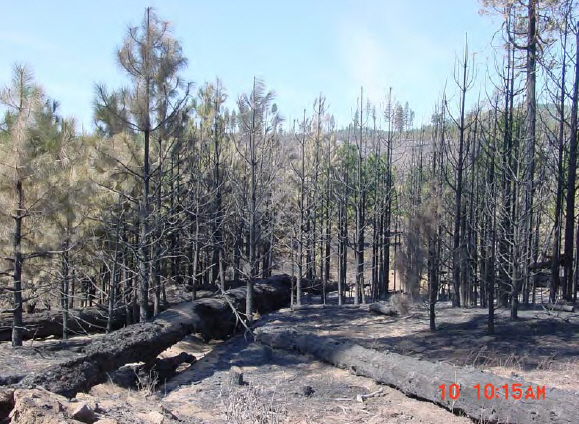The National Park Service today released the report on last August’s Big Meadow escaped prescribed fire in Yosemite National Park. The report was completed on November 9, but it was not made available to the public until today.
The project was intended to be an 89-acre prescribed fire in a meadow in Yosemite Valley, but it was declared a wildfire 55 minutes after completing the test burn. The fire blackened 7,425 acres before being controlled by 1,300 firefighters at a cost over $15 million. It became the eighth largest fire in California in 2009.

Here are some key points from the report. (Passages in “quotes” are taken directly out of the report, word for word. Everything thing else is paraphrased or summarized.)
-
- The test fire began at 10:15 on August 26, 2009. There is conflicting information in the report about the spot fire(s) that occurred at 11:00. There was either a small spot fire outside the perimeter, or there was “group torching of a thicket of small diameter Ponderosa pines” resulting in several spot fires that were suppressed.
- The ignition of the main burn began at 11:15. Five minutes later at 11:20 a spot fire was found 10 feet outside the line in some pine regeneration. At 11:40 two burning snags were discovered outside the line. At 11:55 there were multiple spot fires burning and a helicopter was ordered for water bucket support.
- The project was designated a wildfire at 12:10 and “aggressive suppression action began”.

Reasons for the escape, according to the report
- The prescribed fire plan adhered to official policy, but it “was inadequate as it included a large area with diverse fuel types, topography, and environmental factors. This made it difficult to determine the site specific elements necessary to implement the Big Meadow Unit.”
- The prescribed fire plan used for the prescribed fire was written for the overall “Foresta Complex”, which was comprised of 15 burn units ranging in size from 18 to 1,297 acres with a wide range of vegetation and topography. The report said “the plan lacked the site specific detail for individual units”. The plan was “inadequate for the unit burned” in regard to the loading of heavy fuels and the large number of snags immediately adjacent to and upslope of the burn unit.
- The escape resulted from embers igniting snags and other heavy fuels outside the burn unit and then spread from snag to snag, at times spotting 100 feet ahead. It was difficult or impossible for the firefighters to work safely under and around the burning snags, since burning snags will fall, possibly injuring or killing firefighters.
- “All actions and procedures in the plan were followed”, the report says.
- However, the calculations in the plan for line construction should the fire escape relied heavily on the use of a bulldozer. The park administrators made it clear before igniting the fire that the use of the dozer was discouraged and was not to be used without permission. After the escape, the Burn Boss was not able to immediately contact the administrator for approval, which resulted in a delay in the use of the dozer.

Weather and vegetation conditions prior to the prescribed fire
- The Energy Release Component (ERC) was near the 90th percentile at the time of the project.
- The area was experiencing “abnormally dry” to “moderate drought”.
- Prior to the burn the Burn Boss expected downslope winds early on the day of the burn that would have mitigated any embers generated when a patch of Ponderosa pine near the unit boundary torched, which would have blown the embers back into the burn unit (see photo above). But delays in getting started on the burn day meant that by the time it was ignited and the pines torched, the downslope winds had shifted to upslope, which carried the embers across the line and outside the project boundary.
- The burn unit was mostly grassy meadow with pine reproduction on the edges. The burn plan described the majority of the fuel being “1000 hour plus logs” but did not include 1000 hour fuel moistures in the fuel model prescription.
Policy, guidance, and procedures
- “The acre targets and budget caps associated with the fuel project authorizations for the park add pressure and are magnified by perceived expectations and stressors. The targets can force decisions regarding projects that are situational and not comprehensive as related to the whole of the program complexity and workload.”
- “The Acting Superintendent was actively involved in the planning of the prescribed fire project, engaged directly with the Burn Boss, and approved the burn plan and Go‐No‐Go Checklist. The Acting Superintendent actively participated in the project briefing on the day of ignition. The Acting Superintendent has limited wildland fire and prescribed fire experience and has not attended the Fire Management Leadership curriculum.”
- “All key personnel involved in the prescribed burn met qualifications and were experienced for the assigned positions.”
Personnel and communication
- “The Yosemite National Park organization had several permanent staff vacancies on the date of the Big Meadow prescribed fire. The Acting Park Superintendent and the Acting Deputy Superintendent were detailed into their positions. Several key leadership positions were vacant in the fire management program, which impacted the planning and implementation of the project.”
- “The Yosemite fire management staff is spread over a large area of the park which makes comprehensive communication difficult. Key staff is located in Yosemite Valley, Wawona, and El Portal. This geographic separation degrades communication.”
- “Holding resources consisted of eight single resources: two hand crews, three engines, one dozer, one water tender, and one helicopter. The holding organization exceeded the recommended span of control per Incident Command System (ICS) organization guidance.” Note: the Incident Action Plan for the burn shows 10 resources working directly for the Burn Boss. The ICS guidelines state that one person can supervise three to seven resources, with five being the ideal number.
Some of the lessons learned include:
- Areas covered by multiple-unit burn plans should have similar vegetation, aspects, and elevations.
- “Burning at the high end of the prescription or in peak fire season conditions provides little margin for error. Re‐verify adequacy of the prescription, re‐evaluate the complexity analysis, and affirm the status of fuels and local drought conditions. The measured fuel moistures need to be carefully considered.”
- “Vacancies impact an organization’s ability to complete work. Covering work load expectations for vacant positions contributes to cumulative fatigue.”
- “The prescribed fire was conducted at the upper end of the prescription. Favorable and targeted downwind conditions were not present because of delays.”
And this is an interesting one:
- “The fire management organization had a high tempo and active season to‐date. The prescribed fire team was physically fit and ready for the project. The hubris of success affected the mental state of the team for the Big Meadow prescribed fire.” (emphasis added) The report does not say what the effect was, good or bad, of the “hubris of success”. However, the definition of “hubris” is “excessive pride or self-confidence; arrogance”, so it may not be intended as a compliment.
The members of the review team were:
- Len Dems, National Park Service Intermountain Region, Fire Management Officer‐ Team Leader
- Jim Hutton, National Park Service National Office, Wildland Fire & Fuels Specialist– Technical Expert
- Dave Allen, National Park Service Sequoia & Kings Canyon, District Fire Management Officer – Technical Expert
- Glenn Gibson, U.S. Fish & Wildlife Service Nevada Operations, Fire Management Officer– Technical Expert
- Sid Beckman, National Park Service Pacific West Region, Deputy Fire Management Officer– Technical Expert

Royal,
I mostly agree with your comments, and appreciate your non-federal perpective. Unfortunately, there is a huge rift between competent fire management (fire managers) and experimental land management (land managers playing wit fire) going on within the federal government. When there are disagreements…. guess who wins and conversely who gets the “pointy end of the stick” when things go gunnysack.
There is an unbelievable pressure and burden placed upon fire managers to reach escalating “targets” placed by the bean counters… while at the same time being asked to “do more with less”.
I think the federal land management culture is to blame… not the fire managers and firefighters. They were just doing as they were directed to do by land managers with absolutely no fire experience… I Know… the My Lai defense doesn’t always work.
The NPS review was far too kind.
The Big Meadow RX Fire escape was an error in judgment of epic proportions. The resultant wildfire cost millions of dollars in suppression costs and tied up scores of critically needed fire resources when the State of California was at peak fire season.
Any Prescribed Fire escape is a black eye for managers of all Agencies. One would think that after Cerro Grande the NPS would be more aware of the potential for disaster than other agencies.
Instead of using the phrase “hubris of success” , I think in terms of “misuse of public trust” or preferably “ career ending blunder”.
If the person(s) responsible for lighting that prescribed fire were civilians they would be subject to criminal as well as civil prosecution.